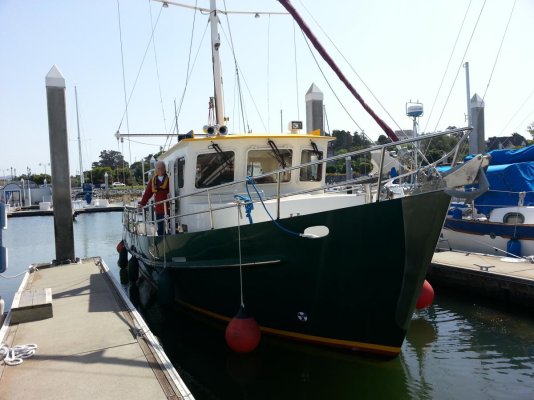LakeMJim
Senior Member
- Joined
- Jun 11, 2021
- Messages
- 142
- Vessel Name
- Mikeno
- Vessel Make
- Grand Banks 36-443 Classic (1974)
I had originally completely written off the idea of buying a trawler big enough to liveaboard.
Not that I don't like the idea, I do, it's the kind of thing I have done all my life (with zero experience building my own place on an island, where winter access was limited, moving to Argentina, then Peru, then Colombia, spending 4 straight years travelling the world etc.)
My ONLY concern was feeling cramped, and I suppose the cost of a new boat or the maintenance on an old boat.
Now as I look around BC and see the crazy property prices, especially for the waterfront I really want, a liveaboard is starting to look more and more attractive.
Of course I would, like anyone, love to have a brand new Grand Banks 44 or a Kadey Krogen or something similar. Or one of the bigger tugs.
But I can't afford that. Or well, I could, but I'd have to go back to work to make sure I had money for fuel.
But a slightly used 42 footer is financially possible for me ($400k to max $600k) while still leaving me a nice retirement fund. I'm a former financial guy so I've done the numbers, very conservatively.
When I ran the idea past my very experienced sailor brother, he said 42 is too big for a guy like me. Alone and inexperienced.
He said I'd rarely leave the marina, as it would be too difficult for me to anchor and dock, even with the fantastic modern bow and stern thrusters.
He suggested 32 to 36 ft would be plenty. (He himself lived aboard a 26 foot sailboat for several years, in Canada, with ice and bubblers and no hot water on board)
I suspect he is right, he usually is. If I was struggling to manage the boat, I'd probably not take it out much.
Thoughts? Can a single person live comfortably on a 30 something foot boat?
The other benefit than easier handling I see is that I could probably afford a brand new 34 or 36 footer.
I'd be in the PNW. I am absolutely not a tropical climate person. I head South for some vacations, but I stay clear of beach resorts when I do. I would probably spend 3 months each winter off the boat, travelling.
Not that I don't like the idea, I do, it's the kind of thing I have done all my life (with zero experience building my own place on an island, where winter access was limited, moving to Argentina, then Peru, then Colombia, spending 4 straight years travelling the world etc.)
My ONLY concern was feeling cramped, and I suppose the cost of a new boat or the maintenance on an old boat.
Now as I look around BC and see the crazy property prices, especially for the waterfront I really want, a liveaboard is starting to look more and more attractive.
Of course I would, like anyone, love to have a brand new Grand Banks 44 or a Kadey Krogen or something similar. Or one of the bigger tugs.
But I can't afford that. Or well, I could, but I'd have to go back to work to make sure I had money for fuel.
But a slightly used 42 footer is financially possible for me ($400k to max $600k) while still leaving me a nice retirement fund. I'm a former financial guy so I've done the numbers, very conservatively.
When I ran the idea past my very experienced sailor brother, he said 42 is too big for a guy like me. Alone and inexperienced.
He said I'd rarely leave the marina, as it would be too difficult for me to anchor and dock, even with the fantastic modern bow and stern thrusters.
He suggested 32 to 36 ft would be plenty. (He himself lived aboard a 26 foot sailboat for several years, in Canada, with ice and bubblers and no hot water on board)
I suspect he is right, he usually is. If I was struggling to manage the boat, I'd probably not take it out much.
Thoughts? Can a single person live comfortably on a 30 something foot boat?
The other benefit than easier handling I see is that I could probably afford a brand new 34 or 36 footer.
I'd be in the PNW. I am absolutely not a tropical climate person. I head South for some vacations, but I stay clear of beach resorts when I do. I would probably spend 3 months each winter off the boat, travelling.



